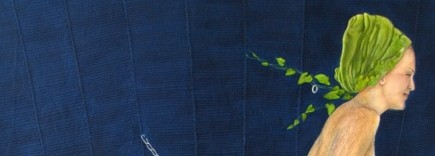Quilt To Last
The relationship between art and crafts is constantly debated and revised within the creative world. Leamington’s latest art exhibition at the Pump Rooms engages with this by presenting a great variety of quilts in terms of shape, size, subject matter, medium and stitching techniques in order to focus on the aesthetic, but also the political, nature of quilting and craftsmanship. This directs the viewer to approach the quilts as pieces of art, rather than functional items coming from an archaic crafting history. However, the craftsmanship and obvious crafting skill that goes into making one of these beautiful quilts is not ignored, as the exhibition includes a film on how quilts and patchwork pieces are made alongside displays of quilting fabric samples that visitors are encouraged to touch.
This exhibition, entitled Through Our Hands, includes work from ten top international quilt artists and teachers, which makes for a vibrant collection of techniques and modern subjects, and undermines traditional prejudices about quilting being a fussy, old fashioned, and predominantly functional craft. Though I feel they still play around with the ‘woman question’ attached to the creation and use of crafts – for a start, all the artists are female, and their work depicts mostly domestic or ‘familiar’ scenes. This however is not a criticism, because although the exhibition can be seen to (re)define quilting as a form of female expression, this focus on the domestic and the feminine ultimately serves to present everyday details as beautiful, something poets and artists alike have been doing for centuries. In addition, these familiar scenes are often pushed into an almost supernatural sphere, and ‘unpicked’ so as to focus on the potential of quilting for conveying, and experimenting with, shape, colour, form and feeling. Through Our Hands is definitely a successful stand for modernising quilting as an artistic form and process.
You don’t have to be a quilting expert to be able to appreciate the variety of different practices this exhibition brings together. This is partly due to the way the exhibition has been curated and hung, as quilts made up of contrasting techniques are juxtaposed within the same hanging space. So an exciting mixture of hand painted quilting, hand appliqué, embellishment, embroidery, and machine or free motion continuous stitching is displayed, giving a great feast for the eyes and senses.
One piece by quilting artist Bethan Ash called I Want To Stitch, 144 x 80cm, is made up of appliqué and text, which I feel is reminiscent of Tracey Emin’s wall hangings – but is a lot neater. With the use of text, Ash’s quilt literally explores what quilting means in a colourful collection of enjambed lines, which state ideas about quilts being a “reflection of our past”, a source of warmth and comfort, defined by shape and colour, and able to impart political ideas and values. This implication of the fluidity of quilts in terms of their function, form and meaning is mirrored in the way each quilt is hung because due to the intense stitching on each piece, the work hangs away from the walls defying any fixed frame and instead suggesting movement and freedom within the stitching lines.
Text is also a feature in Eszter Bornemisza’s pieces that greet the visitor at the beginning of the exhibition. Her work experiments with ideas of evolution within cities and urban life, which she communicates through using rusty brown colours and found materials such as recycled paper and reprinted newspapers. Especially in the piece, City in the Aire’, 300 x 100cm, Bornemisza incorporates birds eye view maps, calligraphy and newspaper text to layer up different methods of communication constructive of city life.
Text is also a fundamental theme in Annabel Rainbow’s three quilts (each roughly 150 x 110cm), through which she explores what it means to be a modern woman pulled in different directions by pressures of motherhood, domesticity and academic success. Her triptych sequence is broken into three poignant but satiric titles, Be the Change You Want, Switching Off, and “Hello Dear. What Did You Do Today?”, which maps the roles available to the modern woman. The feelings that the artist believes these options evoke within a woman are then ‘blistered’ and ingrained onto the skin of the female figures central within each panel’s composition. This dramatic and thought provoking reaction to some of the pressures women face is heightened by the highly detailed domesticity depicted within each scene and the thick dark frames that simultaneously close off and link each section of the triptych together. Due to this, the feeling of claustrophobia and containment is lucidly conveyed beneath what initially appears to be a comfortable domestic interior.
After looking at Rainbow’s work, the quilt Traveller’s Blanket with Circles, 140 x 85cm, by Dijanne Cevaal, appears particularly uplifting. It is one of the most abstract quilts on display, and celebrates pattern and embroidery techniques through a collection of cheerful and vibrant ‘microorganisms’. This definitely captures the energy and movement of travel and memory from which it is inspired.
This exhibition is on until 13 January 2013, which hopefully means no one will miss out on seeing it. Although it is small, I am sure I will be going back several times to savour the diversity, skill and passion that this exhibition exudes. It is a completely refreshing take on quilting that provides a creative platform for exploring this art form and its relationship with craft and modern life.

Comments